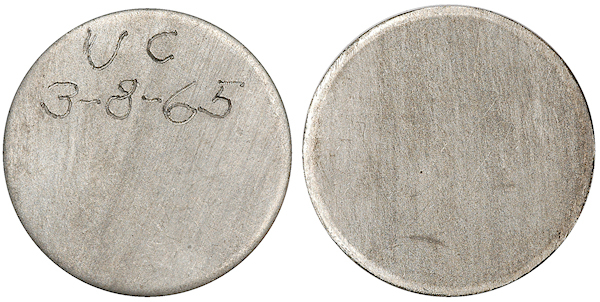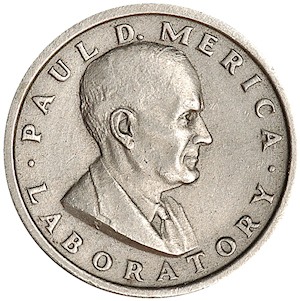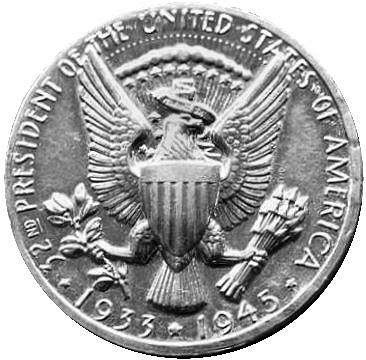Not much to look at, but ---
 RogerB
Posts: 8,852 ✭✭✭✭✭
RogerB
Posts: 8,852 ✭✭✭✭✭
This is one of only 3 known remaining test blanks from the 1964-65 International Nickel Co. coinage experiments made in nearly pure niobium (aka. columbium) 99.6% Nb, 0.4% Si. 
These blanks were made by Union Carbide for Inco, but it’s uncertain if any were used to strike coin-like pattern pieces. This piece is 24.03mm in diameter and could have made a 24.26mm quarter-size sample.
4
Comments
First I'd heard of columbium.
Why was niobium used? It's not exactly a common metal.
RMR: 'Wer, wenn ich schriee, hörte mich denn aus der Engel Ordnungen?'
CJ: 'No one!' [Ain't no angels in the coin biz]
Scores high on the interesting meter. I like it.
Niobium (called "columbium" in contemporary testing documents) was a good electrical and magnetic substitute for 90% silver in coins. It is widely available as ore but projected supplies in 1964 were insufficient for US Mint needs. There was also the "we've never used it" problem.
It looks like copper-nickel as used in the 5-cent coin.
+1
POST NUBILA PHOEBUS / AFTER CLOUDS, SUN
Love for Music / Collector of Dreck
This web site might be helpful for those wondering about niobium and the obsolete "columbium" name. Pure niobium is a superconductor when cooled below 9.25 K - We could have had a little superconducting pocket change (well, if we also carried some liquid helium).
https://education.jlab.org/itselemental/ele041.html
Great piece Roger. I do recall you posted notes or someone did about the mint trying to come up with alternative metals. Perhaps they should us it for some of the exploding cell phones we here of. Then again it might wipe the memory so scratch that.
Thanks for sharing.
Best place to buy !
Bronze Associate member
The lengthy Inco article I'm near completing goes into the search for alternatives for silver coins. I'm waiting for the final puzzle piece.
I don't think niobium could replace lithium in batteries. Maybe it could replace tantalum in dental implants, capacitors and high-capacity resistors?
Robert M Briney, president of the satellite division of Union Carbide Corp. had about 120 tokens made 31.75mm diameter and 4.75mm thick in niobium as samples of the metal. These were produced by the company's Haynes Stellite Metals Division. 100 were given to Senators and others to the Mint for testing. The design was the same on both sides. I've not located a sample for examination, and this is the best photo I've been able to locate.

It may have to if we get into a prolonged trade war with China. China currently controls more than 2/3 of the world's supply of industrially critical metals needed for high-performance alloys.
RMR: 'Wer, wenn ich schriee, hörte mich denn aus der Engel Ordnungen?'
CJ: 'No one!' [Ain't no angels in the coin biz]
Economies are global and interconnected. No one, not even a "stable genius" can change that.
Amen.
"I don't think niobium could replace lithium in batteries. Maybe it could replace tantalum in dental implants, capacitors and high-capacity resistors?"
Correct--the difference in molecular weight is important. Most capacitors, resistors, and other electronic components are tiny (to fit onto printed circuit boards) and in any event are largely produced in East Asia.
RMR: 'Wer, wenn ich schriee, hörte mich denn aus der Engel Ordnungen?'
CJ: 'No one!' [Ain't no angels in the coin biz]
Courtesy of Wikipedia... (partial cut of opening history) - Cheers, RickO
It was not until the early 20th century that niobium was first used commercially. Brazil is the leading producer of niobium and ferroniobium, an alloy of 60–70% niobium with iron. Niobium is used mostly in alloys, the largest part in special steel such as that used in gas pipelines. Although these alloys contain a maximum of 0.1%, the small percentage of niobium enhances the strength of the steel. The temperature stability of niobium-containing superalloys is important for its use in jet and rocket engines.
Niobium is used in various superconducting materials. These superconducting alloys, also containing titanium and tin, are widely used in the superconducting magnets of MRI scanners. Other applications of niobium include welding, nuclear industries, electronics, optics, numismatics, and jewelry. In the last two applications, the low toxicity and iridescence produced by anodization are highly desired properties.
The molybdenum pieces are even more "homely."
Nice information
Successful transactions with : MICHAELDIXON, Manorcourtman, Bochiman, bolivarshagnasty, AUandAG, onlyroosies, chumley, Weiss, jdimmick, BAJJERFAN, gene1978, TJM965, Smittys, GRANDAM, JTHawaii, mainejoe, softparade, derryb, Ricko
Bad transactions with : nobody to date